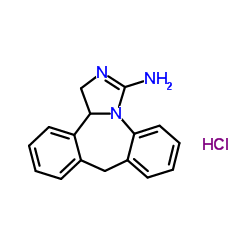Epinastin HCl

Epinastin HCl structure
|
Common Name | Epinastin HCl | ||
|---|---|---|---|---|
| CAS Number | 108929-04-0 | Molecular Weight | 285.771 | |
| Density | 1.32g/cm3 | Boiling Point | 428ºC at 760 mmHg | |
| Molecular Formula | C16H16ClN3 | Melting Point | >270ºC | |
| MSDS | Chinese USA | Flash Point | 212.7ºC | |
| Symbol |

GHS06 |
Signal Word | Danger | |
|
Development and validation of an ultra-performance liquid chromatography method for simultaneous analysis of 20 antihistaminics in dietary supplements.
Biomed. Chromatogr. 29(3) , 465-74, (2015) The purpose of this study was to develop and validate an ultra-performance liquid chromatography method for simultaneous analysis of 20 antihistamines (illegal additives) in dietary supplements. The limits of detection and quantitation of the method ranged fr... |
|
|
Honey bee dopamine and octopamine receptors linked to intracellular calcium signaling have a close phylogenetic and pharmacological relationship.
PLoS ONE 6(11) , e26809, (2011) Three dopamine receptor genes have been identified that are highly conserved among arthropod species. One of these genes, referred to in honey bees as Amdop2, shows a close phylogenetic relationship to the a-adrenergic-like octopamine receptor family. In this... |
|
|
Differential effects of octopamine and tyramine on the central pattern generator for Manduca flight.
J. Comp. Physiol. A. Neuroethol. Sens. Neural. Behav. Physiol. 195(3) , 265-77, (2009) The biogenic amine, octopamine, modulates a variety of aspects of insect motor behavior, including direct action on the flight central pattern generator. A number of recent studies demonstrate that tyramine, the biological precursor of octopamine, also affect... |
|
|
Treatment of allergic conjunctivitis: results of a 1-month, single-masked randomized study.
Eur. J. Ophthalmol. 20(5) , 811-8, (2010) To compare the effects of topical antiallergic eyedrops in relieving the signs and symptoms of patients with allergic conjunctival pathology.In this multicenter, single-masked, randomized study, 240 patients with signs and symptoms of allergic conjunctivitis ... |
|
|
Latent inhibition in an insect: the role of aminergic signaling.
Learn. Mem. 19(12) , 593-7, (2012) Latent inhibition (LI) is a decrement in learning performance that results from the nonreinforced pre-exposure of the to-be-conditioned stimulus, in both vertebrates and invertebrates. In vertebrates, LI development involves dopamine and serotonin; in inverte... |
|
|
Prophylactic effects of the histamine H1 receptor antagonist epinastine and the dual thromboxane A2 receptor and chemoattractant receptor-homologous molecule expressed on Th2 cells antagonist ramatroban on allergic rhinitis model in mice.
Biol. Pharm. Bull. 34(4) , 507-10, (2011) The prophylactic use of anti-allergic drugs has been proposed to be effective in the treatment of seasonal allergic rhinitis in humans. However, there is little information regarding the prophylactic effect of thromboxane A(2) (TXA(2)) receptor antagonist on ... |
|
|
Effect of epinastine hydrochloride on murine self-scratching behavior after skin-scratching stimulation.
Arch. Dermatol. Res. 302(1) , 19-26, (2010) The itch-scratch cycle aggravates chronic inflammatory skin diseases. We have previously reported that mice begin to scratch themselves within several minutes after skin-scratching stimulation. This is associated with an increase in release of substance P (SP... |
|
|
Suppression of histamine- and allergen-induced skin reactions: comparison of first- and second-generation antihistamines.
Ann. Allergy Asthma Immunol. 102(6) , 495-9, (2009) Nonsedating antihistamines (nsAHs) are recommended as first-line therapeutics for the treatment of mast cell-driven disorders, including allergic rhinitis and urticaria. However, their superiority over first-generation AHs (fgAHs) has recently been called int... |
|
|
Epinastine: topical ophthalmic second generation antihistamine without significant systemic side effects.
Expert Opin. Drug Metab. Toxicol. 5(9) , 1135-40, (2009) Epinastine is a topical ophthalmic antihistamine and a mast cell stabilizer indicated for treatment of symptoms associated with allergic conjunctivitis.The objective of this review is to provide a comprehensive overview of the pharmacology, clinical efficacy,... |
|
|
Ocular comfort and drying effects of three topical antihistamine/mast cell stabilizers in adults with allergic conjunctivitis: a randomized, double-masked crossover study.
Clin. Ther. 30(7) , 1264-71, (2008) The aim of this study was to compare short-term (5-minute) ocular comfort and drying effects of 3 topical antihistamine/mast cell stabilizers-epinastine, azelastine, and ketotifen-in patients with allergic conjunctivitis (AC).Adults with a history of AC, as c... |